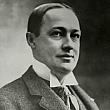John Edward Brower
John Brower was born in Chicago, December 12, 1859. He was educated in the public schools and studied architecture with several Chicago architects.
When he turned to furniture, Brower’s first experience was in the John A. Colby Company’s Chicago retail store, where he served as a special designer of furniture. In those days many of the retail stores made furniture on order and in most cases all upholstered furniture was built by the retail stores, little of it being sold by manufacturers.
Later, Brower was employed by the Tobey Furniture Company, pursuing the same activities as at the John A. Colby So. Store. In 1890, E.H. Foote, president and general manager of the Grand Rapids Chair Company, persuaded him to come to Grand Rapids and take up designing for this concern. After several years with the Chair Company, he made a connection with Philip Klingman and Charles Limbert, forming a firm known as Klingman, Limbert & Brower. Limbert was the manufacturer of the furniture Brower designed, and Klingman sold it. After this firm dissolved, Brower went to the Charles P. Limbert Company, for which he designed Mission furniture.
During the World’s Fair in St. Louis, 1904, Brower became interested in the remarkable exhibits of Austrian “modern” furniture, which later was known as “Austrian-Swiss.” This furniture is described in the chapter on the Twentieth Century Renaissance. It resembled closely the early Austrian modern art, which came to this country in 1925. Brower was extremely “modern-minded” and it is quite certain that, had he lived longer, he would have taken up with contemporary furniture with enthusiasm.
For years John E. Brower was with the Sligh Furniture Company and later “free-lanced” in designing and producing patterns for many of the outstanding manufacturers throughout the country. He died May 22, 1914, at the age of 55. He was one of the well-beloved characters of the furniture industry. He was known from coast to coast for his cryptic statements and individual opinions. The furniture industry unanimously agreed that his death removed one of its most brilliant and capable leaders.
Excerpted from Furniture World and Furniture Buyer & Decorator, 1936, pages 127.

 facebook
facebook